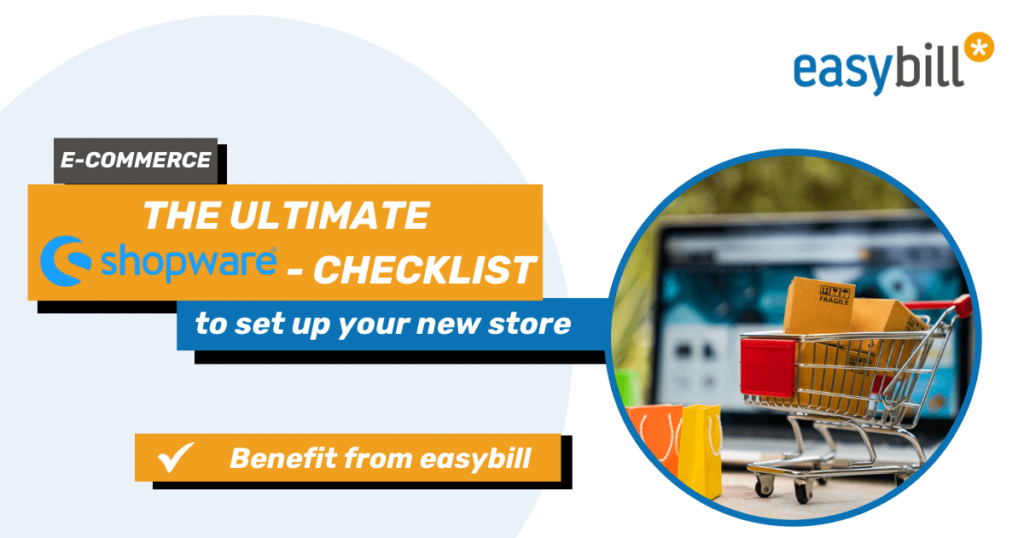
Reading time: approx. 8 Minutes
January 24, 2024
Choosing the right e-commerce platform is a crucial step for any online retailer, especially if you want to serve not only the B2C market but also the B2B sector, where the requirements are often more complex. Shopware has established itself as one of the leading platforms for online retail and setting up a new store requires careful planning and implementation. In this blog post, we provide you with the ultimate Shopware checklist to help you set up your new Shopware store efficiently.
Step 1: Planning and target definition
Before you start setting up your Shopware store, it is crucial to define a clear strategy and goals. Ask yourself:
- What products or services will you be selling?
- Who is your target group in the B2B or B2C sector and what are their needs?
- Which functions and features do you need for an effective sales process?
Step 2: Shopware installation and configuration
- Choose hosting: Opt for reliable hosting that meets the requirements of your store.
- Install Shopware: Use the official Shopware website to access the latest version and start the installation.
- Make basic settings: Configure important basic settings such as languages, currencies and tax rates.
Step 3: Customize design and layout
- Select theme: Choose an appealing and functional theme that suits your B2B business.
- Logo and color scheme: Personalize your store design by adding your logo and defining the color palette.
- Responsive design: Ensure that your store is optimally displayed on different devices.
Step 4: Add products and categories
- Create products: Add your products, including product images, descriptions and prices.
- Structure categories: Organize your products into meaningful categories and subcategories for a better overview.
- Define variants and attributes: Use Shopware’s functions for product variants and attributes to offer a comprehensive variety of products.
Step 5: Set up payment methods and shipping options
- Configure payment methods: Integrate common payment methods such as PayPal, credit card, invoice, etc.
- Define shipping options: Define shipping costs, delivery times and shipping service providers.
Step 6: Fulfill legal requirements
- Create terms and conditions, data protection and legal notice: Make sure that your store meets all legal requirements.
- Observe legal requirements: Pay attention to country-specific laws and regulations in the B2B sector.
Step 7: Do not neglect SEO optimization
- Keyword research: Use relevant keywords for your products and integrate them into product descriptions and meta tags.
- SEO-friendly URLs: Design search engine friendly URLs for better visibility in search results.
Step 8: Testing and troubleshooting
- Carry out test orders: Check the entire ordering process from start to finish.
- Test mobile and browser compatibility: Ensure that your store works optimally on different devices and browsers.
Step 9: Integrate marketing and analysis tools
- Integrate Google Analytics: Track the success of your store with detailed analyses.
- Use marketing tools: Implement marketing tools such as newsletters, discounts and voucher codes.
Step 10: Ensure training and support
- Training for employees: If you have a team, train your employees in the use of Shopware.
- Provide support options: Offer customer support through multiple channels to quickly resolve questions and issues.
With this comprehensive checklist, you are optimally prepared to set up your Shopware store successfully. Remember that continuous maintenance and optimization of your store is crucial for long-term success. Good luck with setting up your successful Shopware store!
Read also:
Price increases and other annoyances – switching made easy
6 practical tips for switching to standard taxation
Link Shopware 6 with easybill
FAQ about setting up a Shopware store
Opt for reliable hosting that meets your requirements. Use the latest Shopware version and start with the configuration. Make the basic settings by defining the language, currencies and tax rates. Choose a suitable theme, integrate the logo and design the colors. Then add your products with images, descriptions and prices. Finally, configure payment options and shipping conditions to ensure an optimal user experience for your customers.
Before you go live with Shopware, you should consider the following points: Make sure your store meets all legal requirements, including terms and conditions, privacy policy and legal notice. These should be easily accessible to your customers. Test your own store! Go through the entire ordering process to ensure that everything works smoothly. Ensure that all payment methods are correctly integrated and that the shipping options meet your requirements. Make sure your website is SEO-optimized with relevant keywords, search engine friendly URLs and meta tags so that your products can be found by potential new customers. Install a data backup. Back up your data so that you can restore it quickly in the event of problems or data loss.
Finally, prepare your team for live operation and ensure that your customer support is available.
After carefully checking these points, you will be well prepared to successfully go live with your Shopware store.




